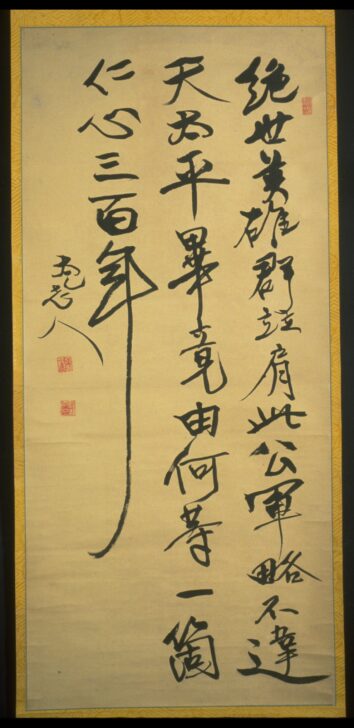Poem in Running Script
Murase Taiitsu

Description
Gallery Rotation Winter 2012
Murase Taiitsu
Japan, 1804–1881
Chinese poem in running script
Late Edo period to early Meiji period (1830–1900)
19th century
Hanging scroll, ink on paper
Gift of Kurt A. Gitter in memory of Dr. Harold P. Stern, 1977/1.185
Murase Taiitsu was trained primarily as a Confucius scholar but excelled at both calligraphy and painting. He produced paintings of figures and landscapes accompanied by poems, as well as works of pure calligraphy such as the one seen here. This example is a tribute to a military figure whose leadership exemplified ren (benevolence), the highest Confucian virtue.
Taiitsu was a member of a group of Japanese painters who followed the styles and ideas of the Chinese Southern School of literati (non-professional artist-scholar) painting that flourished during the Ming period (1368–1644). Taiitsu, considered by many a notable eccentric, brought his singular touch to the tradition. A distinctive feature of his brushstroke is its dancing quality, which conveys an exuberance and vigor lacking in the work of his fellow Japanese literati painters, who adhered more closely to Chinese styles.
Subject Matter:
Murase Taiitsu was trained primarily as a Confucius scholar but excelled at both calligraphy and painting. He produced paintings of figures and landscapes accompanied by poems, as well as works of pure calligraphy such as the one seen here. This example is a tribute to a military figure whose leadership exemplified Ren (benevolence), the highest Confucian virtue.
Taiitsu was a member of a group of Japanese painters who followed the styles and ideas of the Chinese Southern School of literati (non-professional artist-scholar) painting that flourished during the Ming period (1368–1644). Taiitsu, considered by many a notable eccentric, brought his singular, personal touch to the tradition. A distinctive feature of his brushstroke is its dancing quality, which conveys an exuberance and vigor lacking in the work of his fellow Japanese literati painters, who adhered more closely to Chinese styles.
Physical Description:
This calligraphy is executed in ink on paper. There are a total of three red seals present in the piece, one in the upper right hand corner, and two towards the left center of the piece. The calligraphy is very strong and forceful, with broad, well defined strokes. The work is mounted on golden silk.
Usage Rights:
If you are interested in using an image for a publication, please visit https://umma.umich.edu/request-image/ for more information and to fill out the online Image Rights and Reproductions Request Form.